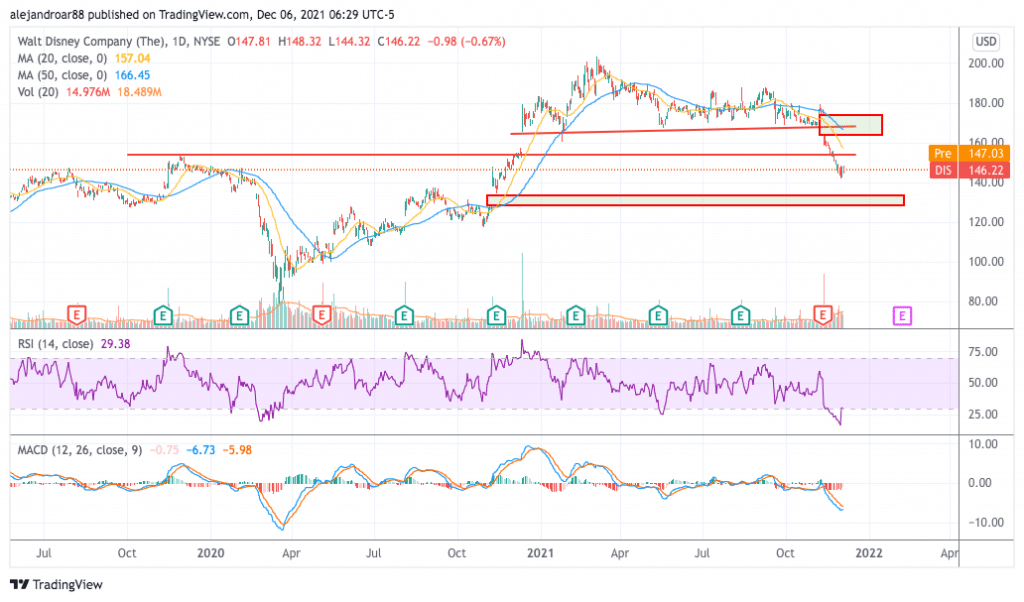Disney Stock Down 19% in 2021 – Time to Buy DIS stock?
Please note that we are not authorised to provide any investment advice. The content on this page is for information purposes only.
The price of Disney stock has gone down more than 19% so far this year following the sharp decline that it has experienced since the company’s financial results covering the fourth quarter of its 2021 fiscal year were published.
Back on 11 November, DIS stock declined as much as 7% – its worst losing stock trading session since the year started – while the stock has shed over 16% since that day.
A disappointing figure concerning the number of new users added to its Disney+ streaming platform seems to have fueled this latest downtrend in the price of this entertainment stock.
Meanwhile, the appearance of the omicron variant in the United States has also contributed to the post-earnings decline as the Centers for Disease Control and Prevention (CDC) announced that more than 20 cases have already been identified in the country. The agency also warned that omicron cases will “likely rise” in the following days as the variant appears to be more transmissible than its predecessors.
For Disney (DIS), the implementation of strict social distancing protocols, limited attendance, and other similar measures would prolong the firm’s virus-related pains and may depress for longer than expected the recovery of its parks and experiences operation.
With this in mind, what could be expected from DIS stock now that 2022 is just around the corner? In this article, I’ll be assessing its price action and fundamentals to outline plausible scenarios for the future.
67% of all retail investor accounts lose money when trading CFDs with this provider.
Disney Stock – Technical Analysis

The decline that Disney stock experienced on 11 November following the release of its Q4 2021 earnings report along with the negative momentum created by the omicron-related news have pushed the price below its short-term and mid-term moving averages while multiple supports have been broken including the stock’s pre-pandemic high of $154 per year.
In my latest article about Disney, I emphasized that the downside risk for the stock was high as the performance of Disney+ was primarily responsible for the uptrend we witnessed in 2020 even as the pandemic was ravaging the firm’s core business.
In this regard, it seems that market participants were so disappointed about the performance of this unit during this latest quarter that they have decided that the stock is worth less than it did before the virus crisis started.
Now that the 11 December open gap has been filled and the 2020 all-time high has failed to provide support for the stock, it seems that market participants could be eyeing the early November 2020 open gap as the next target for Disney stock.
That results in a total downside risk of around 12% for Disney stock and momentum indicators support this view as both the Relative Strength Index (RSI) and the MACD are neck-deep into oversold levels and are not currently displaying any signs that their decline is decelerating.
Upon closing that gap, it would be plausible to expect that Disney stock may rebound in the short term as long as the omicron situation remains under control. On the other hand, any signs that the virus variant might be resistant to vaccines could result in further waves of panic selling.
Therefore, even though the outlook might improve once we get to those levels – at around $128 per share – the virus situation will remain one of the most important catalysts to keep an eye on both for better or for worst.
Disney Stock – Fundamental Analysis
From a fundamental perspective, two factors are weighing on the performance of Disney stock at the moment. The first is related to the pace at which the firm can resume its parks and experiences operations to the point that they recover to pre-pandemic levels.
During the 2021 fiscal year, this segment generated revenues of $16.55 billion compared to the $26.23 billion it brought back in the 2019 fiscal year.
The second factor playing a role in shaping Disney’s stock performance is the growth of its Direct-to-Consumer & International segment – which includes the revenues coming from Disney+ and other streaming platforms owned by the company.
Back in 2019, revenues from this segment were $9.35 billion and accounted for only 13% of the firm’s top-line results. In 2021, DTC brought $16.32 billion, accounting for around 24% of Disney’s top line.
The combination of clear signs that Disney’s parks and experiences segment is recovering along with the continuous growth of its DTC segment are the two positive catalysts that can propel the stock in 2022.
For now, the outlook is bearish as downside risks are high considering that market participants will probably want to close that open gap we highlighted before. If that happens, the stock would trade at a forward P/E ratio of approximately 30.
Meanwhile, the price would be standing at around 16% below Disney’s pre-pandemic all-time high despite its growth prospects being very promising considering that the company now has a brand new and strong revenue stream that may continue to improve its top and bottom-line performance for years to come.






